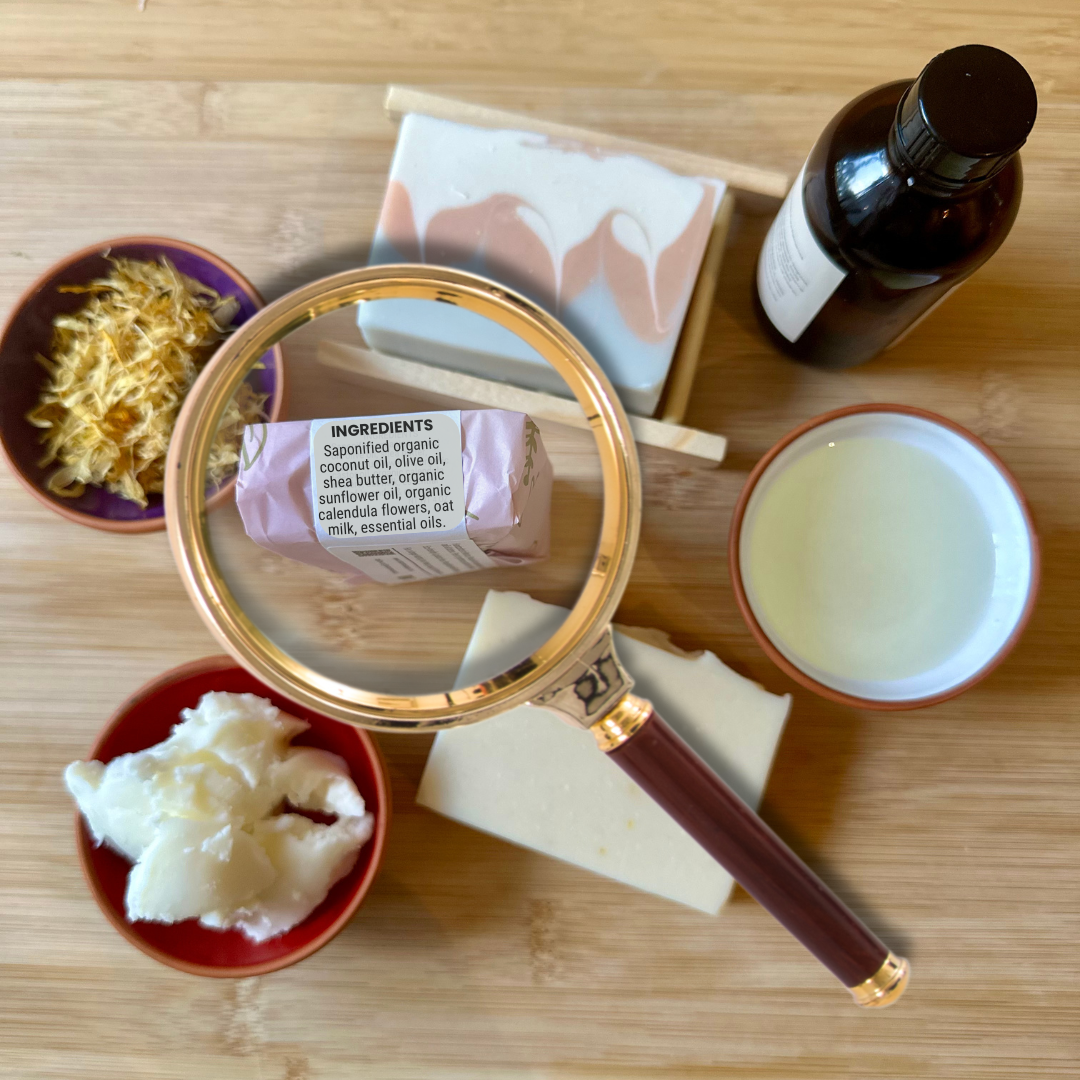
The Great Soap Ingredient Detective Work: What's Really in Your Bar?
Share
Let's play a little game. Grab that bar of soap from your bathroom (you know, the one you picked up from the grocery store because it was on sale) and flip it over to read the ingredients. Go ahead, I'll wait.
Back? Feeling a little overwhelmed by that paragraph of unpronounceable words? You're definitely not alone. If deciphering your soap's ingredient list feels like trying to crack the Da Vinci Code, it's time we had a little heart-to-heart about what's actually touching your skin every single day.
The Plot Twist: Your Soap Might Not Be Soap
Here's something that'll make you do a double-take: many commercial "soaps" aren't technically soap at all. They're detergent bars. Real soap is made through a process called saponification, where oils and fats react with an alkali (like lye) to create, well, soap. But those mass-produced bars? They're often loaded with synthetic detergents, sulfates, and a cocktail of chemicals that would make a chemistry teacher's head spin.
The difference isn't just semantic – it's about how your skin feels after every wash. Ever notice how some soaps leave your skin feeling tight, dry, or even itchy? That's your skin sending you a not-so-subtle message about those harsh ingredients.
The Usual Suspects: Ingredients That Make Your Skin Say "Nope"
Let's talk about the ingredients that pop up in conventional soaps like uninvited party guests:
Sodium Lauryl Sulfate (SLS) is the overachiever of the soap world – it creates lots of foam and bubbles, which makes us feel like it's working harder. But SLS can be incredibly drying and irritating, especially for sensitive skin. It's like using dish soap on your face (which, let's be honest, we've all done in desperate times).
Parabens are the preservatives that keep your soap shelf-stable for years, but they're also endocrine disruptors that can mess with your hormones. Not exactly what you want in your daily routine.
Artificial fragrances might make your soap smell like a tropical vacation, but they're often made up of dozens of undisclosed chemicals that can trigger allergies and skin reactions.
Triclosan was the antibacterial darling until we realized it might be contributing to antibiotic resistance and hormone disruption. Even the FDA has raised eyebrows at this one.
Going Natural: What Actually Belongs on Your Skin
Now for the good news – soap doesn't have to be complicated. Traditional soap-making uses ingredients you could literally eat (though I wouldn't recommend it). Think olive oil, coconut oil, shea butter, and essential oils. These ingredients have been keeping humans clean for thousands of years, and they do it without the side effects.
When you choose handcrafted, natural soaps, you're getting ingredients that work with your skin instead of against it. Olive oil is naturally moisturizing. Coconut oil creates a rich, creamy lather. Shea butter soothes and protects. Essential oils provide gentle, natural fragrance that won't send your sinuses into overdrive.
The Allergy Factor: Why Nut-Free Matters More Than You Think
Here's something many people don't realize: if you or someone in your household has nut allergies, your soap choice matters more than you might think. Nut oils are common in both commercial and artisanal soaps, and while topical exposure rarely causes the same reaction as ingestion, it's still a risk worth avoiding.
The tricky part? Nut ingredients don't always scream "I'M A NUT!" on the label. Sweet almond oil, argan oil, and even some "natural" fragrances can contain nut-derived ingredients. For families dealing with severe allergies, having one less thing to worry about in the bathroom is actually a huge relief.
Reading Labels Like a Pro: Your Cheat Sheet
When you're soap shopping, here's what to look for:
The Short List Rule: If the ingredient list reads like a novel, keep looking. Quality soap doesn't need 30+ ingredients to do its job.
Recognize the Good Guys: Look for plant-based oils (olive, coconut, sunflower, castor), natural butters (shea, cocoa), and essential oils for fragrance.
Spot the Red Flags: If you see sulfates, parabens, artificial colors, or ingredients you can't pronounce, that's your cue to keep shopping.
Check the Process: Words like "saponified" or "handcrafted" usually indicate traditional soap-making methods.
The Sustainability Bonus Round
While we're talking ingredients, let's not forget about packaging. That plastic bottle your body wash comes in? It's probably going to outlive your great-grandchildren. Bar soap, especially when it comes in minimal, biodegradable packaging, is inherently more sustainable. You're getting more product, less waste, and fewer chemicals going down your drain and into waterways.
Making the Switch: What to Expect
If you've been using commercial soap for years, switching to natural ingredients might feel different at first. Your skin might go through a brief adjustment period as it recalibrates to gentler ingredients. Some people notice their skin feels less tight immediately, while others see improvements in dryness or irritation over a few weeks.
The lather might be different too – natural soaps often produce a creamier, less aggressive foam. Don't worry, it's still cleaning effectively. Sometimes less really is more.
The Bottom Line
Your soap is probably the first thing that touches your skin in the morning and the last thing at night. It's worth taking a few extra minutes to make sure those ingredients are working for you, not against you. Whether you're dealing with sensitive skin, allergies, or just want to know what you're putting on your body, reading those labels and choosing thoughtfully crafted products isn't just good for your skin – it's good for the planet too.
So next time you're soap shopping, channel your inner detective. Your skin (and your bathroom cabinet) will thank you for it.